
Surrealism - I
Surrealism
The Surrealists sought to channel the unconscious as a means to unlock the power of the imagination. Disdaining rationalism and literary realism, and powerfully influenced by psychoanalysis, the Surrealists believed the rational mind repressed the power of the imagination, weighing it down with taboos. Influenced also by Karl Marx, they hoped that the psyche had the power to reveal the contradictions in the everyday world and spur on revolution. Their emphasis on the power of personal imagination puts them in the tradition of Romanticism, but unlike their forebears, they believed that revelations could be found on the street and in everyday life. The Surrealist impulse to tap the unconscious mind, and their interests in myth and primitivism, went on to shape many later movements, and the style remains influential to this today.
Surrealism grew out of the Dada movement, which was also in rebellion against middle-class complacency. Artistic influences, however, came from many different sources. The most immediate influence for several of the Surrealists was Giorgio de Chirico, their contemporary who, like them, used bizarre imagery with unsettling juxtapositions. They were also drawn to artists from the recent past related to Primitivism, and Symbolism, who were interested in naive, or fantastical imagery, such as Gustave Moreau, Arnold Bocklin, Odilon Redon, and Henri Rousseau. Even artists from as far back as the Renaissance, such as Giuseppe Arcimboldo and Hieronymous Bosch, provided inspiration in so far as these artists were not overly concerned with aesthetic issues involving line and color, but instead felt compelled to create what Surrealists thought of as the "real."
The Surrealist movement began as a literary group strongly allied to Dada, emerging in the wake of the collapse of Dada in Paris, when André Breton's eagerness to bring purpose to Dada clashed with Tristan Tzara's anti-authoritarianism. Breton, who is occasionally described as the 'Pope' of Surrealism, officially founded the movement in 1924 when he wrote The Surrealist Manifesto. However, the term "surrealism," was first coined in 1917 by Guillaume Apollinaire when he used it in program notes for the ballet Parade, written by Pablo Picasso, Leonide Massine, Jean Cocteau, and Erik Satie.
Around the same time that Breton published his inaugural manifesto, the group began publishing the journal La Révolution surréaliste, which was largely focused on writing, but also included art reproductions by artists such as de Chirico, Max Ernst, André Masson, and Man Ray. Publication continued until 1929.
The Bureau for Surrealist Research or Centrale Surréaliste was also established in Paris in 1924. This was a loosely affiliated group of writers and artists who met and conducted interviews to "gather all the information possible related to forms that might express the unconscious activity of the mind." Headed by Breton, the Bureau created a dual archive: one that collected dream imagery and another that collected materials related to social life. At least two people manned the office each day - one to greet visitors and the other to write down the observations and comments of the visitors that then became part of the archive. In January 1925, the Bureau officially published its revolutionary intent that was signed by 27 people, including Breton, Ernst, and Masson.
Surrealism shared much of the anti-rationalism of Dada. The original Parisian Surrealists used art as a reprieve from violent political situations and to address the unease they felt about the world's uncertainties. By employing fantasy and dream imagery, artists generated creative works in a variety of media that exposed their inner minds in eccentric, symbolic ways, uncovering anxieties and treating them analytically through visual means.
Though Surrealism originated in France, strains of it can be identified in art throughout the world. Particularly in the 1930s and 1940s, many artists were swept into its orbit as increasing political upheaval and a second global war encouraged fears that human civilization was in a state of crisis and collapse. The emigration of many Surrealists to the Americas during WWII spread their ideas further. Following the war, however, the group's ideas were challenged by the rise of Existentialism, which, while also celebrating individualism, was more rationally based than Surrealism. In the arts, the Abstract Expressionists incorporated Surrealist ideas and usurped their dominance by pioneering new techniques for representing the unconscious. Breton became increasingly interested in revolutionary political activism as the movement's primary goal. The result was the dispersal of the original movement into smaller factions of artists. The Bretonians, such as Roberto Matta, believed that art was inherently political. Others, like Yves Tanguy, Max Ernst, and Dorothea Tanning, remained in America to separate from Breton. Salvador Dalí, likewise, retreated to Spain, believing in the centrality of the individual in art.
In 1936, the Museum of Modern Art in New York staged an exhibition entitled Fantastic Art, Dada, Surrealism, and many American artists were powerfully impressed by it. Some, such as Jackson Pollock, began to experiment with automatism, and with imagery that seemed to derive from the unconscious - experiments which would later lead to his "drip" paintings. Robert Motherwell, similarly, is said to have been "stuck between the two worlds" of abstraction and automatism.
Largely because of political upheaval in Europe, New York rather than Paris became the emergent center of a new vanguard, one that favored tapping the unconscious through abstraction as opposed to the "hand-painted dreams" of Salvador Dalí. Peggy Guggenheim's 1942 exhibition of Surrealist-influenced artists (Rothko, Gottlieb, Motherwell, Baziotes, Hoffman, Still, and Pollock) alongside European artists Miró, Klee, and Masson, underscores the speed with which Surrealist concepts spread through the New York art community.
The Surrealists have often been depicted as a tightly knit group of men, and their art often envisioned women as wild "others" to the cultured, rational world. Work by feminist art historians has since corrected this impression, not only highlighting the number of women Surrealists who were active in the group, particularly in the 1930s, but also analyzing the gender stereotypes at work in much Surrealist art. Feminist art critics, such as Dawn Ades, Mary Ann Caws, and Whitney Chadwick, have devoted several books and exhibitions to this subject.
While most of the male Surrealists, especially Man Ray, Magritte, and Dalí, repeatedly focused on and/or distorted the female form and depicted women as muses, much in the way that male artists had for centuries, female Surrealists such as Claude Cahun, Lee Miller, Leonora Carrington, and Dorothea Tanning, sought to address the problematic adoption of Freudian psychoanalysis that often cast women as monstrous and lesser. Thus, many female Surrealists experimented with cross-dressing and depicted themselves as animals or mythic creatures.
Interestingly, many notable female Surrealists were British. Examples include Eileen Agar, Ithell Colquhoun, Edith Rimmington, and Emmy Bridgwater. Particular to the British interpretation of Surrealist ideology was an ongoing exploration of human relations with their surrounding natural environment and most prominently, with the sea. Alongside Agar, Paul Nash developed an interest in the object trouvé, usually in the form of items collected from the beach. The focus on the border where land meets the sea, and where rocks anthropomorphically resemble people struck a chord with British identity and more generally, with Surrealist principles of reconciling and uniting opposites.
The International Surrealist Exhibition (1936) held in London was a particular catalyst for many British artists. Headed by Roland Penrose and Herbert Read, the movement thrived in Britain, creating the international icons Leonora Carrington and Lee Miller, and also spurring on the practice of another important circle of artists surrounding Ben Nicholson, Barbara Hepworth, and Henry Moore. Overall, the privileging of an eccentric imagination and essential rejection of standardized and rational modes of doing things resonated well from the outset. This golden period for art in general in the UK, and more specifically the legacies of British Surrealism continue to influence the country’s art practice today.
Pierre Roy
1880 – 1950
Pierre Roy
(10 August 1880 – 26 September 1950) was a French surrealist painter. He is known for his realistically painted compositions of ordinary objects in unexpected arrangements.
He was the eldest of four children of the secretary of the management board of the Musée d'Arts de Nantes who all became amateur painters. After gaining his baccalauréat at the local school he joined a firm of architects before enrolling at the Ecole des Beaux-Arts in Paris. Disappointed with the course, he left to work on the designs for the 1900 Paris Exposition.
In 1905, he decided to devote himself to painting, beginning in 1906 at the Salon of the Société Nationale des Beaux-Arts (SNBA), a painters collective. He exhibited in 1907, 1908, 1913 and 1914 at the Société des Artistes Indépendants. In 1925, he took part in the first exhibition by surrealist painters alongside Giorgio de Chirico, Max Ernst and Pablo Picasso, and in 1926 had his first solo exhibition.[2] In 1933 he was appointed for five years as a naval artist.
An exhibition devoted to his work was held at the Galerie des Beaux-Arts in Paris in 1935, and his work was displayed at the 1937 World's Fair and the Montaigne Gallery in Paris in 1938. He travelled and exhibited in galleries around the world: in New York at the Brummer Gallery in 1930 and 1933, at the Julien Levy Gallery in 1932, at the Museum of Modern Art in New York in 1936, at the Carstairs Gallery in 1949, in London in 1934, at the Wildenstein Gallery and in Hawaii in 1939 at the Honolulu Academy of Arts.
In addition he created stage sets, several covers for Vogue magazine, and advertising posters.
His work is classed as surrealism, and is based on assemblages of everyday objects such as shells, vegetables and fruits, woollen reels, ears and seeds, eggs and ribbons arranged to create poetic images.

Pierre Roy. Self portrait.

Still Life with Bottles and Breton Bonnets
Pierre Roy
1924

Proue de naivre et papillons
Pierre Roy
1925

Le grand bateau
Pierre Roy
1927

Danger on the Stairs
Pierre Roy
.1928

A Naturalist's Study
Pierre Roy
1928

Le chou-fleur
Pierre Roy
1931

La Fortune au repos
Pierre Roy

Prognostication
Pierre Roy

Boris Anrep in his Studio, 65 Boulevard Arago
Pierre Roy
1949

Fun physics
by Pierre Roy
Stanisław Witkiewicz
1885 – 1939

Kuszenie św. Antoniego II, 1921–1922

Stanisław Witkiewicz
Stanisław Ignacy Witkiewicz (24 February 1885 – 18 September 1939), commonly known as Witkacy, was a Polish writer, painter, philosopher, theorist, playwright, novelist, and photographer active before World War I and during the interwar period.
Born in Warsaw, Stanisław Ignacy Witkiewicz was a son of the painter, architect and an art critic Stanisław Witkiewicz. His mother was Maria Pietrzkiewicz Witkiewiczowa. Both of his parents were born in the Samogitian region of Lithuania. His godmother was the internationally famous actress Helena Modrzejewska.
Witkiewicz was reared at the family home in Zakopane. In accordance with his father's antipathy to the "servitude of the school," he was home-schooled and encouraged to develop his talents across a range of creative fields. Against his fathers wishes he studied at the Kraków Academy of Fine Arts with Józef Mehoffer and Jan Stanisławski.
Witkiewicz was close friends with composer Karol Szymanowski and, from childhood, with Bronisław Malinowski and Zofia Romer. Romer was romantically linked to both Bronisław Malinowski and Witkiewicz. He had a tumultuous affair with prominent actress Irena Solska who according to Anna Micińska is represented as the heroine Akne Montecalfi in his first novel, The 622 Downfalls of Bungo or The Demonic Woman, 1911. According to Micińska he also represented himself as the character Bungo and Malinowski as the Duke of Nevermore. The unfinished novel, which was not published until 1972, also describes erotic encounters between Bungo and the Duke of Nevermore. Taught wet plate photography by his father, it was during this period that he also began producing the intimate portrait photography for which he is known; producing striking portraits of his circle in Zakopane and many self-portraits.

Portret Michała Choromańskiego, 1928

The Falsehood of Woman

Portrait of Maria Nawrocka

'Portrait of Nena Stachurska' by Stanisław Ignacy Witkiewicz, 1929

Creation of the World

Walka, 1920

Rąbanie lasu. Walka.

Marysia with the dog Burek on Ceylon.

Visiting a Maharaja

Composition.
Mariano Andreu
1888–1976

Mariano Andreu
(1888–1976) was a Spanish painter, drawer, enamelling master, sculptor, and stage designer.
He was born in Mataró in 1888 and lived his early childhood above the Teatro Circo Barcelonés in the Calle Montserrat. Early on he was affiliated to the "Noucentistes" movement, named by his friend Eugenio d'Ors. He studied in London under Alexander Fisher an enamaller of the Central Arts & Crafts School in London. Returning to Barcelona Andreu made one of the world's largest enamels, the triptych "L'Orb" using contemporary enamelling techniques of the day.
He left Spain for Paris, with his wife Philomene ("Filo") Stes, he became involved in stage design; he carried out works such as Voleur d'Images, Sonatina for the Opéra-Comique in 1929, La guerre de Troie n'aura pas lieu for Louis Jouvet's Théâtre de l'Athénée (1935). For the Ballet Russe de Monte Carlo he designed costumes and sets for Capriccio Espagnol, which premiered in Monte Carlo in 1939. He designed costumes for the 20th Century Fox film That Lady (1955, starring Olivia de Havilland and Paul Scofield) and the short ballet film Spanish Fiesta (1942).
He was invited to London by John Gielgud to design the sets and costumes for Shakespeare's Much Ado about Nothing, in 1949. He also designed the sets and costumes for Hector Berlioz's Les Troyens, directed by Gielgud at Covent Garden in 1957. In 1951 he designed Sir Alec Guinness's Hamlet and in 1955 All's Well That Ends Well, for Noel Willman.
Early exhibitions in London were seen at the Claridge Gallery and the Leicester Galleries.
Throughout his life Andreu produced some 30 Livres de Luxe, for which he early on gained an enviable reputation as one of the finest lithographers and illustrators of his day.
His work is held in many public and private collections in France, the United States, Great Britain and Spain.

Mariano Andreu

Mariano Andreu

Mariano Andreu

Mariano Andreu

Mariano Andreu

Mariano Andreu

Mariano Andreu

Mariano Andreu

Mariano Andreu

Mariano Andreu

Mariano Andreu

Mariano Andreu

Mariano Andreu

Mariano Andreu

Mariano Andreu

Mariano Andreu

Mariano Andreu

Mariano Andreu

Mariano Andreu
Paul Nash
1889 – 1946
Paul Nash
(11 May 1889 – 11 July 1946) was a British surrealist painter and war artist, as well as a photographer, writer and designer of applied art. Nash was among the most important landscape artists of the first half of the twentieth century. He played a key role in the development of Modernism in English art.
Born in London, Nash grew up in Buckinghamshire where he developed a love of the landscape. He entered the Slade School of Art but was poor at figure drawing and concentrated on landscape painting. Nash found much inspiration in landscapes with elements of ancient history, such as burial mounds, Iron Age hill forts such as Wittenham Clumps and the standing stones at Avebury in Wiltshire. The artworks he produced during World War I are among the most iconic images of the conflict. After the war Nash continued to focus on landscape painting, originally in a formalized, decorative style but, throughout the 1930s, in an increasingly abstract and surreal manner. In his paintings he often placed everyday objects into a landscape to give them a new identity and symbolism.
During World War II, although sick with the asthmatic condition that would kill him, he produced two series of anthropomorphic depictions of aircraft, before producing a number of landscapes rich in symbolism with an intense mystical quality.[3] These have perhaps become among the best known works from the period. Nash was also a fine book illustrator, and also designed stage scenery, fabrics and posters.

Paul Nash, self-portrait

Paul Nash, Spring in the Trenches, Ridge Wood, 1917

Paul Nash, The Ypres Salient at Night (1918)

Paul Nash, Wire (1919)

Paul Nash, We Are Making a New World (1918)

Paul Nash, Defence of Albion (1942)

Paul Nash, The Mule Track (1918)

Paul Nash, The Menin Road (1919)

Paul Nash, Battle of Britain (1941)

Paul Nash, Battle of Germany (1944)

Paul Nash, Landscape of the Vernal Equinox (1943)
Rudolf Schlichter
1890 – 1955
Rudolf Schlichter
(December 6, 1890 – May 3, 1955) was a German painter, engraver and writer. He was one of the most important representatives of the critical-realistic style of verism within the New Objectivity movement. He also wrote some autobiographical books.
Schlichter was born in Calw, Württemberg. He lost his father early, and grew up as the youngest of six siblings. His mother, who worked as a seamstress, was a Protestant, while his father, a professional gardener, was a Catholic. According to his fathers wish, the children were brought up as Catholics. He attended the Latin school in Calw until the sixth grade.
He started in 1904 an apprenticeship as an enamel painter at a Pforzheim factory. After that he attended the State Academy of Fine Arts, in Stuttgart, from 1907 to 1909. He subsequently studied at the Academy of Fine Arts, in Karlsruhe, under Hans Thoma and Wilhelm Trübner, among others, from 1910 to 1916. Already during his studies, Schlichter developed into an artist who saw himself related to contemporary bohemian ideals and in rebellion against traditional bourgeois values.
Shlichter liked to portray himself as a dandy at the time, following his role model, Oscar Wilde. Schlichter undertook various study trips to Strasbourg, in Alsace, to Italy and France, and got contacts to the underworld through fellow painter Julius Kaspar. He visited Berlin for the first time around 1910, where his brother Max Schlichter (1882–1932) was head chef at the renowned Hotel Kaiserhof. As a dandy-like flaneur through the streets of the capital, with its light and dark districts, he experienced "the uninterrupted succession of fear experiences - especially through the presence of whores, gays, criminals in these streets - (these) triggered in him a panicky "thrill" that his small-town experience and adventure potential blew up".
Because of his short-sightedness, Schlichter was initially exempt from military service during the First World War. He would eventually be deployed as a munitions driver on the Western Front, but returned from there the following year after a hunger strike done to secure an early release. In 1918 he became a member of a soldiers' council.

Rudolf Schlichter Self-portrait

Blind power, 1932-1937, by Rudolf Schlichter (1890-1955)

Rudolf Schlichter (1890-1955) — Composition with the Head of Woman
1950

Schlichter, Rudolf
Monkey and mythical creature on a seesaw
1954

SCHLICHTER, RUDOLF
Apocalyptic Scene

Schlichter, Rudolf
The Schafberg (Mountain in the Salzburg region)
1950

Rudolf Schlichter (1890-1955) — “At Dawn he entered uncertain Ground”
1951

PORTRÄT HELENE WEIGEL (1928)
Rudolf Schlichter

JEUNESSE DORÉE (1922)
Rudolf Schlichter

Rudolf Schlichter, Berlin Hausvogteiplatz, 1926

Rudolf Schlichter, Tingel-Tangel, 1919

The Rooftop Studio, 1922, Rudolf Schlichter

Phanomen, Rudolf Schlichter

Reptiles, 1948, Rudolf Schlichter

The ‘degenerate art’ of Rudolf Schlichter

Schlichter, Rudolf
Untitled

Schlichter, Rudolf
“Transformation” 1949

Schlichter, Rudolf
“Grossstadtvision” 1925

Schlichter, Rudolf
“Speedy Schlichter” 1952.

The Artist with Two Hanged Women
Rudolf Schlichter
1924

Schlichter, Rudolf
Untitled

Schlichter, Rudolf
Untitled
Joan Miro
1893 – 1983

Joan Miró
Joan Miró i Ferrà (20 April 1893 – 25 December 1983) was a Spanish painter, sculptor and ceramicist born in Barcelona. He was known as Joan Miró in the art recognition. A museum dedicated to his work, the Fundació Joan Miró, was established in his native city of Barcelona in 1975, and another, the Fundació Pilar i Joan Miró, was established in his adoptive city of Palma in 1981.
Earning international acclaim, his work has been interpreted as Surrealism but with a personal style, sometimes also veering into Fauvism and Expressionism. He was notable for his interest in the unconscious or the subconscious mind, reflected in his re-creation of the childlike. His difficult-to-classify works also had a manifestation of Catalan pride. In numerous interviews dating from the 1930s onwards, Miró expressed contempt for conventional painting methods as a way of supporting bourgeois society, and declared an "assassination of painting" in favour of upsetting the visual elements of established painting.
JOAN MIRO

JAN STEEN: DUTCH INTERIOR
JOAN MIRO: DUTCH INTERIOR

JOAN MIRO: DUTCH INTERIOR I. 1928.

JOAN MIRO: DUTCH INTERIOR II. 1928.

JOAN MIRO: DUTCH INTERIOR III. 1928.

The Farm, 1921–1922

Joan Miró, 1920, Horse, Pipe and Red Flower

Joan Miró, The Tilled Field, (1923–1924)

Joan Miró, Nude

Joan Miró, The Farm

Nude with Mirror, Joan Miro, 1919

The Table (Still Life with Rabbit), Joan Miro, 1920

Portrait of a Spanish Dancer, Joan Miro, 1921

Joan Miró, The Family, 1924

Joan Miró, The Hunter (Catalan Landscape), (1923–1924)

Harlequin's Carnival, 1924-25, by Joan Miro

Joan Miró, Person Throwing A Stone At A Bird

JOAN MIRO: Untitled. 1928.

ANDRÉ BRETON, YVES TANGUY, MARCEL DUCHAMP, MAX MORISE: EXQUISITE CADAVER. AROUND 1926 -1928

ANDRÉ BRETON, YVES TANGUY, MARCEL DUCHAMP, MAX MORISE: EXQUISITE CADAVER. AROUND 1926 -1928

ANDRÉ BRETON, YVES TANGUY, MARCEL DUCHAMP, MAX MORISE: EXQUISITE CADAVER. AROUND 1926 -1928

ANDRÉ BRETON, YVES TANGUY, MARCEL DUCHAMP, MAX MORISE: EXQUISITE CADAVER. AROUND 1926 -1928

Portrait of Mrs Mills in 1750 (after Constable)
Joan Miro
1929

Rhythmic Characters
Joan Miro
1934

Woman and Dog in Front of the Moon
Joan Miro
1935

Figures in Front of a Metamorphosis
Joan Miro
1936
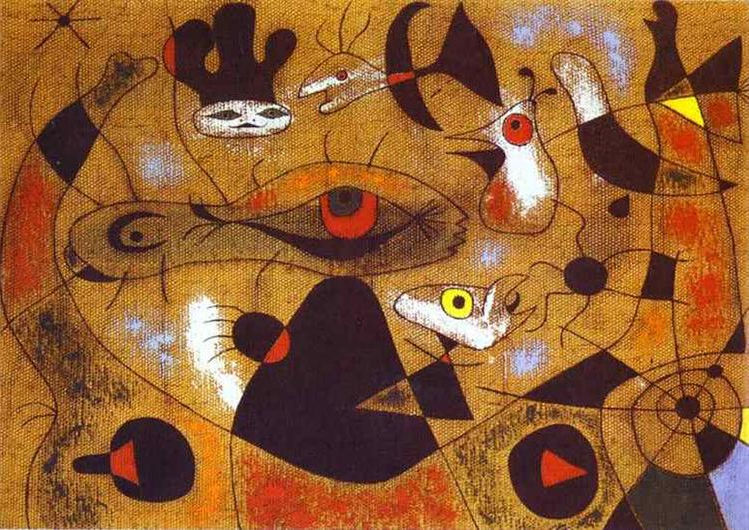
A Dew Drop Falling from a Bird's Wing Wakes Rosalie, who Has Been Asleep in the Shadow of a Spider's Web
Joan Miro
1939

Figure at Night Guided by the Phosphorescent Tracks of Snails
Joan Miro
1940

The Red Sun Gnaws at the Spider
Joan Miro
1948

Characters in the Night
Joan Miro
1950

Joy of a Girl in the Sun
Joan Miro
1960

Characters and Birds Party for the Night That Is Approaching
Joan Miro
1968

Burnt Canvas I
Joan Miro
1973

Sol de Miró
Joan Miro
1983
Andre Masson
1896 - 1987

André Masson. Pedestal Table in the Studio (1922)

Andre Masson
(b Balagne, 4 Jan 1896; d Paris, 28 Oct 1987).
French painter, draughtsman, printmaker and stage designer. His work played an important role in the development of both SURREALISM and ABSTRACT EXPRESSIONISM, although his independence, iconoclasm and abrupt stylistic transitions make him difficult to classify. Masson was admitted to the Académie Royale des Beaux-Arts et l’Ecole des Arts Décoratifs in Brussels at the age of 11. Through his teacher Constant Montald, he met the Belgian poet Emile Verhaeren (1855–1916), who persuaded Masson’s parents to send him to Paris for further training. Masson joined the French infantry in 1915 and fought in the battles of the Somme; he was gravely wounded, and his wartime experiences engendered in him a profound philosophy about human destiny and stimulated his search for a personal imagery of generation, eclosion and metamorphosis.

André Masson. Automatic Drawing (1924)

Armour
Andre Masson
1925

Furious Suns
Andre Masson
1925

Battle of Fishes
Andre Masson
1926

Battle of the Fishes
Andre Masson
1927

Removal
Andre Masson
1932

The horses of Diomedes
Andre Masson
1934

Iconic views of Toledo
Andre Masson
1936

The pianotaure
Andre Masson
1937

Returning from the execution
Andre Masson
1937

The Metamorphosis of the Lovers
Andre Masson
1938

The painter and the time
Andre Masson
1938

Gradiva
Andre Masson
1939

Portrait of the poet Kleist
Andre Masson
1939

There is no world ended
Andre Masson
1942

Couple in the night
Andre Masson
1958

No Name
Andre Masson

ANDRÉ MASSON
THE LABYRIN
1938
Paul Delvaux
1897 – 1994

Paul Delvaux
(23 September 1897 – 20 July 1994) was a Belgian painter noted for his dream-like scenes of women, classical architecture, trains and train stations, and skeletons, often in combination. He is often considered a surrealist, although he only briefly identified with the Surrealist movement. He was influenced by the works of Giorgio de Chirico and René Magritte, but developed his own fantastical subjects and hyper-realistic styling, combining the detailed classical beauty of academic painting with the bizarre juxtapositions of surrealism.
Throughout his long career, Delvaux explored "Nude and skeleton, the clothed and the unclothed, male and female, desire and horror, eroticism and death – Delvaux's major anxieties in fact, and the greater themes of his later work.

Paul Delvaux
Pygmalion
1939

Paul Delvaux
La escalera

Paul Delvaux
El hombre de la calle

Paul Delvaux
The sleeping Venus

Paul Delvaux
Nymphs Bathing
1938

Paul Delvaux
At the Door

Paul Delvaux
The Iron Age

Paul Delvaux
Congres

Paul Delvaux
Unknown

Paul Delvaux
Elogio de la melancolia

Paul Delvaux
Mujeres de vida galante

Paul Delvaux
Las cortesanas

Paul Delvaux
The Public Voice

Paul Delvaux
Woman in a Cave

Paul Delvaux
La ville inquiete

Paul Delvaux
Les promeneuses

Paul Delvaux
El enigma

Paul Delvaux
The Break of Day

Paul Delvaux
Amanecer en la ciudad

Paul Delvaux
Final del viaje

Paul Delvaux
Leda

Iron age
Paul Delvaux
1951

Crucifixion
Paul Delvaux
1952

The Lustre
Paul Delvaux
1952

The Annunciation
Paul Delvaux
1955

School of researchers
Paul Delvaux
1958
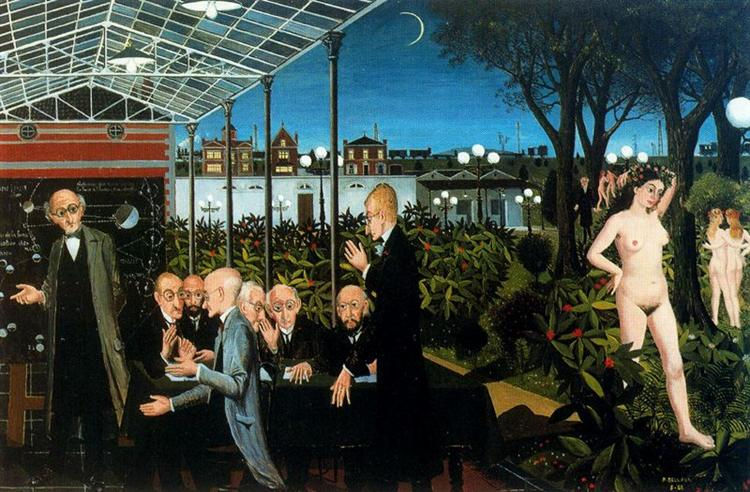
Astronomers
Paul Delvaux
1961

Silent Night
Paul Delvaux
1962

The Beautiful Night
Paul Delvaux
1962

The girls from the provinces
Paul Delvaux
1962
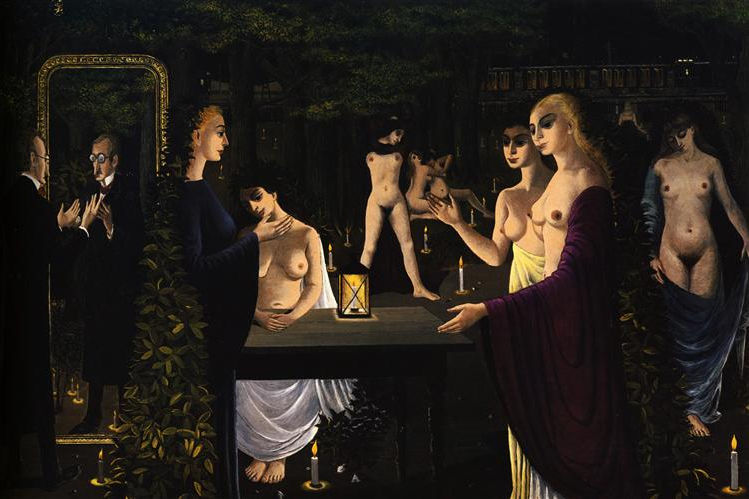
The Sabbath
Paul Delvaux
1962

Abandonment
Paul Delvaux
1964

Dryads
Paul Delvaux
1966

Chrysis
Paul Delvaux
1967

The Blue Sofa
Paul Delvaux
1967

Little Marie
Paul Delvaux
1969
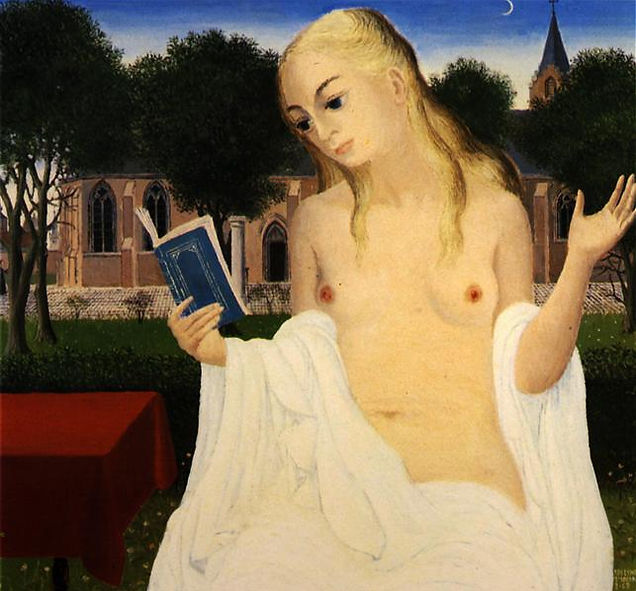
The Lady of Loos
Paul Delvaux
1969

Pompei
Paul Delvaux
1970

The Garden
Paul Delvaux
1971

The Office of Evening
Paul Delvaux
1971

Tribute to Jules Verne
Paul Delvaux
1971

Ruins of Selinunte
Paul Delvaux
1973

The Visit to Ephesus
Paul Delvaux
1973
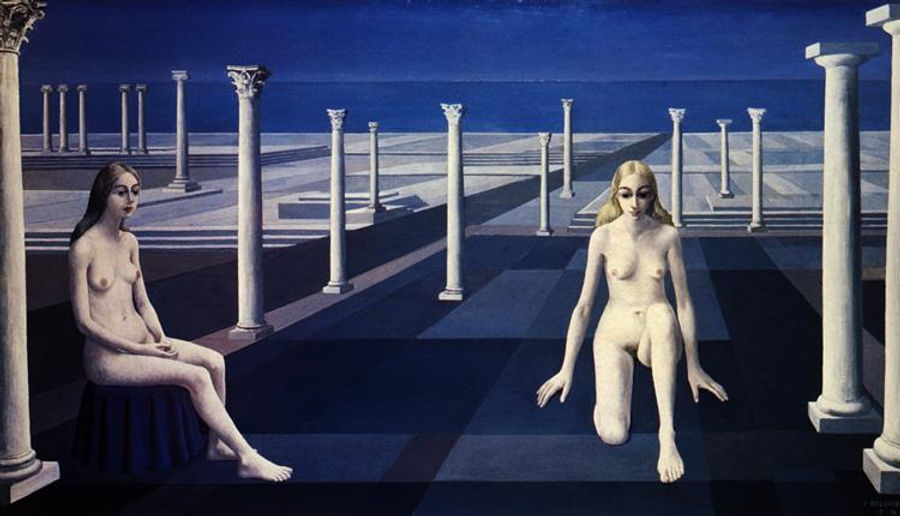
Dialogue
Paul Delvaux
1974

Night Sea
Paul Delvaux
1976

The Next
Paul Delvaux
1977

The Tunnel
Paul Delvaux
1978

Sirens
Paul Delvaux
1979

Messaging
Paul Delvaux
1980